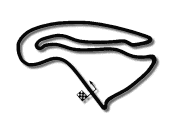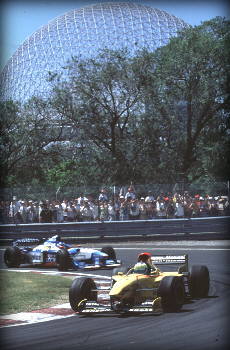Renault bid to make
it ‘first’ and ‘last’ in 83rd
French Grand Prix at Magny Cours. Schumacher should
take advantage of Villeneuve’s impetuosity
 The French have more motor racing
circuits than any other European country. With at
least 25 in irregular use, there are probably more
tucked away behind vineyards and deep within forests,
that probably even the French don’t know about.
Auto racing was introduced in France with the
establishment of the Auto Club de France in
1895 and a city to city race between Bordeaux and
Paris. With an international series inaugurated by
the American Newspaper mogul James Gordon Bennett
in 1900, the ‘Coupe Internationale’
became a hotly contested race for the Gordon
Bennett cup. But with the massive death toll that
City to City racing brought (12 people died in the
Paris-Madrid race in 1903 including one of the
Renault brothers, Marcel), and the fact that the
rules, laid down by the American precluded the
national entry to a maximum of three cars, the ACF
refused any further participation in the Gordon
Bennett races. The name of the race was changed in
1906 to the Grand Prix de l’ACF hence
introducing the now common epithet to all subsequent
international competitions.
The French have more motor racing
circuits than any other European country. With at
least 25 in irregular use, there are probably more
tucked away behind vineyards and deep within forests,
that probably even the French don’t know about.
Auto racing was introduced in France with the
establishment of the Auto Club de France in
1895 and a city to city race between Bordeaux and
Paris. With an international series inaugurated by
the American Newspaper mogul James Gordon Bennett
in 1900, the ‘Coupe Internationale’
became a hotly contested race for the Gordon
Bennett cup. But with the massive death toll that
City to City racing brought (12 people died in the
Paris-Madrid race in 1903 including one of the
Renault brothers, Marcel), and the fact that the
rules, laid down by the American precluded the
national entry to a maximum of three cars, the ACF
refused any further participation in the Gordon
Bennett races. The name of the race was changed in
1906 to the Grand Prix de l’ACF hence
introducing the now common epithet to all subsequent
international competitions.
The first Grand Prix
of 12 laps in the same year, was held over two days
on a 65mile(105km) circuit near Le Mans and was won
by one Ferenc Szisz in a 13 litre 4 cylinder
works Renault. Since then the French Grand Prix has
had many venues. Circuits at Reims, Dijon
in Burgundy and the Paul Ricard circuit at Le
Castellet near Marseilles, hosted the majority in
later times, but Pau in the foothills of the
Pyrenees, Albi near Toulouse, Rouen les
Essarts in Northern France and the Louis
Rosier circuit at Charade near
Clermont-Ferrand, all hosted races.
The French Grand Prix
has always been eventful. The 1926 race at Miramas,
contested by 3 Bugattis, due to a
constructor’s strike, was the smallest in GP
history. It also boasted the longest winning margin
of 15 laps. In 1953 Mike Hawthorn gave his
first win for Ferrari narrowly beating Fangio’s
Maserati at the final turn. 1960 saw the Cooper
Climax take the most definitive victory of all
time when Jack Brabham lead them home 1, 2, 3 and
4. 73 years after Renault’s first win, Jean-Pierre
Jabouille scored the second for the Marque and a
first for a turbocharged car. The race was memorable
for the fantastic wheel banging duel for second place
between Gilles Villeneuve in a Ferrari and Rene
Arnoux in the second Renault, in which positions
were exchanged several times in the last lap. The
Ferrari took the place by just 0.24 of a second. Alain
Prost won the first of his 51 races at Dijon and
returned to win three times in a row in ’88,
‘89’ and ’90 at Paul Ricard.
The Circuit de
Nevers at Magny Cours, near Nevers,
originally the proving ground of many French drivers
passing through the Winfield Racing School, was
totally refurbished in 1988, when French President
Mitterrand took an interest in bringing Grand Prix
racing to a largly rural area, enabling it to become
the regular home to the French Grand Prix, the first
of which was held in 1991. The Ligier Formula
1 team (now Prost) made their home their in
purpose-built accommodation beside the track and have
only recently moved to larger premises near Paris. It
is the first of a series of fast tracks that form the
mid part of the F1 season and is a mix of medium
corners, tight hairpins and long, fast curves.
Magny Cours is
perhaps, the most notorious track when it comes to
changes in temperature and atmospheric conditions. Gary
Anderson, Jordan Peugeot’s technical director
says, "The weather plays an important part,
as the track usually becomes hot and therefore
slippery" If it is warm, Gary went on,
"In qualifying instead of the teams waiting
until the end of the session to make the best times,
there is usually a rush to get out early before it
becomes too hot. Overall the set-up is a balance
between downforce and strait line speed. Downforce
for the Estoril bend and straight line speed so you
can be quick at the end of the straight and overtake
(under braking) at Adelaide (Hairpin)."

Young Jordan Peugeot driver Giancarlo Fisichella
after driving to a brilliant 3rd place at the
Canadian Gran Prix, Said, "Magny Cours is a
good circuit for me because I love chicanes and so it
suits my driving style. I do not really enjoy the
hairpin (Adelaide), because it is so slow and the 180
degree bend is also slow and you usually have
problems with understeer. It is a medium grip circuit
but the track surface is really smooth which is
excellent."
The most important
corner in qualifying according to the majority of
drivers, is the final tight right hander (Lycee)
that leads into the start-finish straight. Putting
power down hear is extremely important and has to be
done firmly but progressively. Ralf Schumacher
says, "Lycee, which is a very low grip corner
is very important because it affects your speed on
the straight."
Alan Jenkins,
technical director of Stewart Grand Prix says of the circuit, "The
most notable feature, is that the track is
billiard-table smooth. This and the nature of the
surface itself, means that finding a set-up can be a
very specific task. It can be a nightmare until you
dial into the circuit. We made quite major gains in
set-up over the recent two days we tested here."
This should be
expected of course, as all the teams have tested here
at some point over the last few months and
configurations should prove to be quickly attainable
at the weekend.
It looks like Austrian
Alexander Wurz who exceeded expectations
executing his duties for Benetton in Canada will be driving for
the team again, as Gerhard Berger still
suffering from his sinus complaint underwent a second
minor operation. Team boss Flavio Briatore is
expected to wait until the last moment before making
any decision.
Things on the other
hand, don’t look so rosy for Team boss Alain
Prost. His driver Olivier Panis who crashed
badly in Montreal fracturing both legs, will be out
of contention at least until Monza. The highly
rated Jarno Trulli has been given leave from Minardi to fill his seat, but Prost is
also giving consideration to ex-Williams test driver Emmanuel Collard,
current test driver Jean-Christophe Boullion and
his own, Tarzo Marques.
Both the Williams drivers especially Jacques
Villeneuve will be looking to restore the faith
that Frank Williams seems to be sorely in need
of. With the French Grand Prix approaching the half
way point in the season, the Canadian has finished in
only three of the seven races so far albeit winning
them. Michael Schumacher has taken advantage
of this fact and with Ferrari ever increasing in strength,
Villeneuve although quick and, in the quickest car,
must lose his impetuosity and start to construct an
intelligent race approach rather than the ‘Gung
Ho’ manner on which the ‘boy’ in him
seems to thrive.
Jean Todt
Ferrari’s team director said after Montreal, "I
will never be happy until we are in a winning
position. When I arrived at Ferrari we were in a very
difficult situation. We now have a proper team, but
we still have a lot to achieve. There is so much to
be done now and we are working to close the gap.
Previously it was a question of a year, now it is a
matter of months." Words that Villeneuve
should heed, for that ‘matter of
months’, could already be weeks. Ferrari are
currently ahead both in the Driver’s and
Constructor’s championships and consistency is
what the Didcot team badly need.
After being the
‘nearly man’ in Canada McLaren’s David Coulthard
will be looking to consolidate his hand with the
vastly improved Mercedes engine that made such
an impressive debut at Montreal.
The good news for Damon
Hill in the Arrows, was that he finished a race
and whilst we should not expect anything more from
him this weekend, the team are regarding this as a
major stepping stone because of the amount of extra
data they have acquired through bringing both cars
across the finishing line.
It is good to see thus
far in the season, that the bestowal of race honours
is not a forgone conclusion for the favoured few. As
we have seen over the last couple of races, the
mid-field is rapidly catching up with the front
runners. Fisichella, Rubens Barrichello,
Coulthard, Jean Alesi and even Alex Wurz all
have a chance to bite at the winner’s apple. A
continuously disappointing Heinz Harald Frentzen
will not help Williams put that extra spurt to the
line but the sheer bravado and dazzling car control
of Schumacher will.
Chris Richardson

